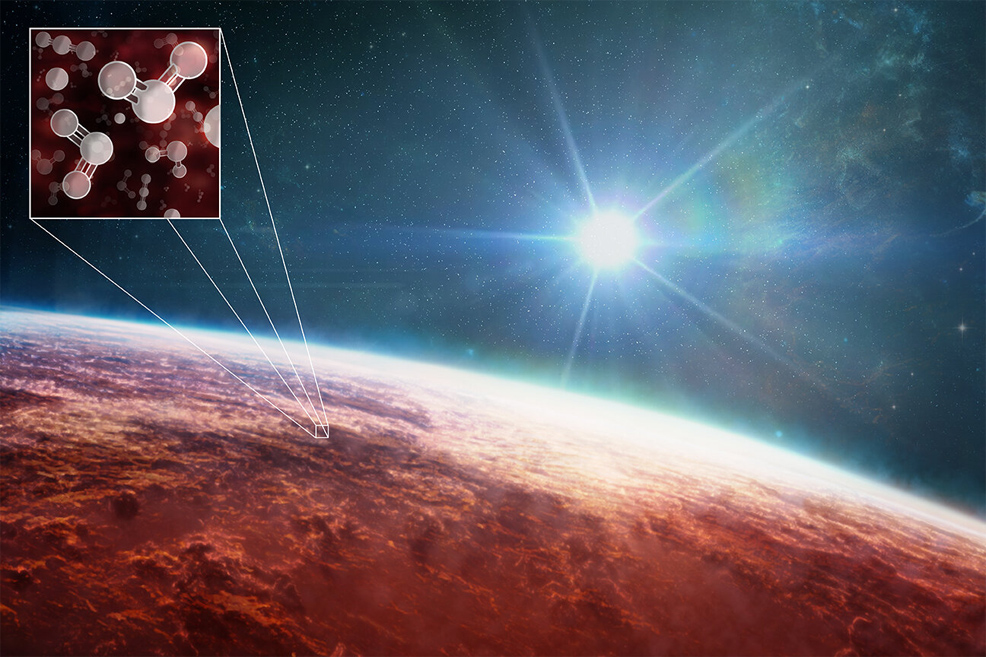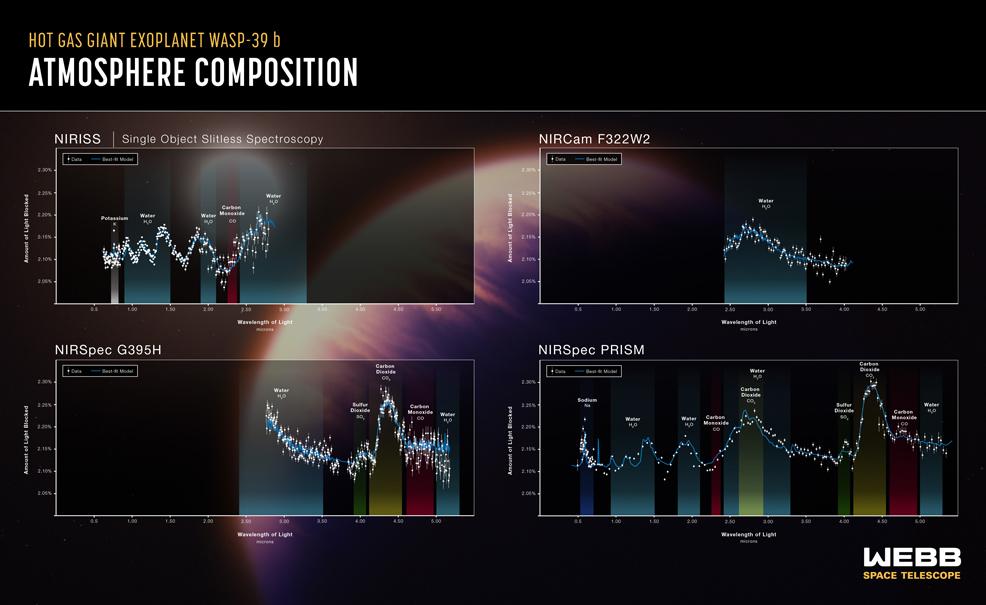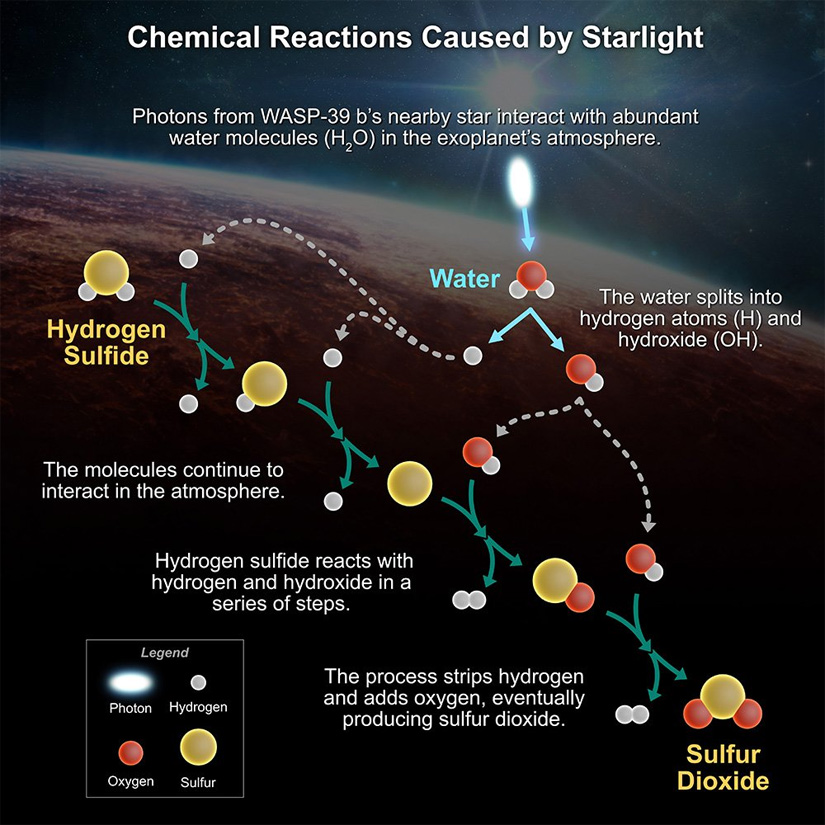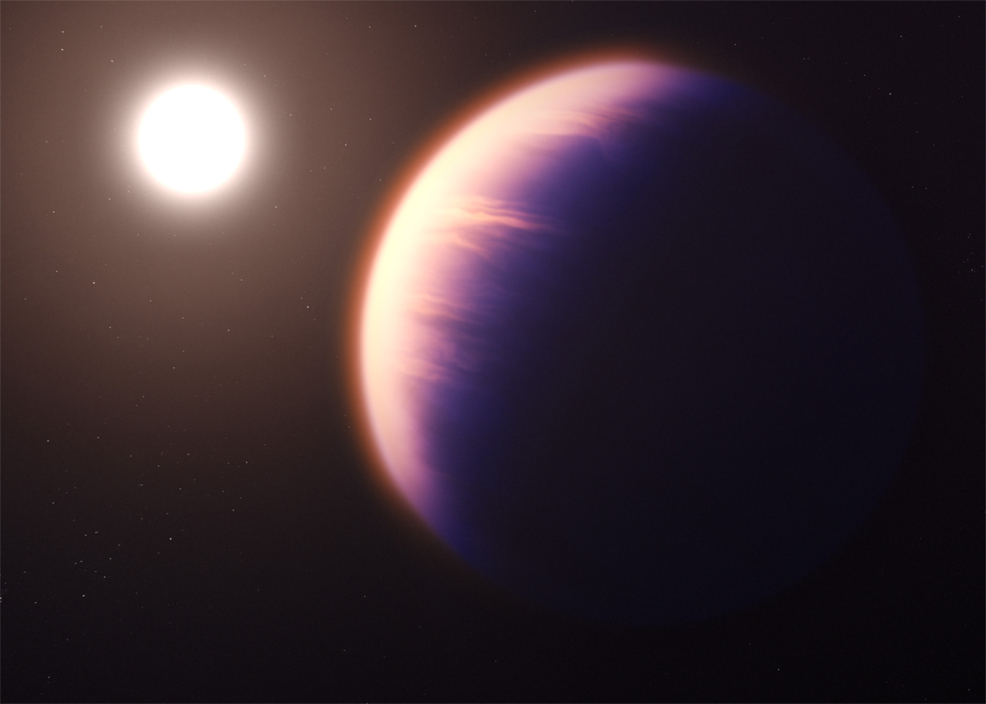
27th November 2022 Photochemistry is confirmed on an exoplanet For the first time, photochemistry is confirmed to be happening on a planet beyond our own Solar System. The James Webb Space Telescope (JWST) has detected a range of signatures including sulfur dioxide in the atmosphere of WASP-39b.
Photochemistry is the result of light triggering chemical reactions. This process is fundamental to life on Earth: it makes ozone, for example, which protects us from harsh ultraviolet (UV) rays. New observations of WASP-39 b, a Jupiter-sized planet orbiting a Sun-like star found 700 light years away, confirm the presence of a never-before-seen molecule in the atmosphere – sulfur dioxide – among other details. The James Webb Space Telescope has previously studied WASP-39 b. In August, it captured the first clear evidence for carbon dioxide. Now, it has focused its array of highly sensitive instruments on the planet once again, revealing not just an isolated ingredient, but a full menu of atoms, molecules, and even signs of active chemistry and clouds in the broiling atmosphere. This latest data, far more detailed than any previous telescope, shows the amazing capabilities of Webb, and hints at the potential for future discoveries that may reveal biosignatures.
Click to enlarge
"The clarity of the signals from a number of different molecules in the data is remarkable," says Mercedes López-Morales, an astronomer at Harvard and Smithsonian's Center for Astrophysics, who contributed to the new results. "We had predicted that we were going to see many of those signals, but still, when I first saw the data, I was in awe." The latest data improves our understanding of how clouds in "hot Jupiter" exoplanets like this might appear up close. They are likely to be broken up, rather than a single, uniform blanket over the planet. As shown above (click to enlarge), Webb's instruments detected a total of six chemical species: carbon dioxide (CO2), carbon monoxide (CO), potassium (K), sodium (Na), sulfur dioxide (SO2), and water (H2O). Webb observed carbon dioxide at even higher resolution than its previous study in August, providing twice as much data this time. Having such a complete roster of chemical types can tell scientists about the abundance of different elements in relation to each other, such as carbon-to-oxygen or potassium-to-oxygen ratios. That, in turn, provides insight into how this planet – and perhaps others – formed out of the disk of gas and dust surrounding the parent star in its younger years. In the case of WASP-39 b, its chemical inventory suggests a history of collisions and mergers of smaller bodies that created an eventual giant of a planet. The findings bode well for the capability of Webb's instruments to conduct a broad range of investigations of all types of exoplanets – including the atmospheres of smaller, rocky planets like those in the TRAPPIST-1 system. "We observed the exoplanet with multiple instruments that, together, provide a broad swath of the infrared spectrum and a panoply of chemical fingerprints inaccessible until [this mission]," said Natalie Batalha, an astronomer at the University of California, Santa Cruz, who contributed to and helped coordinate this new research. "Data like these are a game changer." The suite of discoveries is detailed in a set of five scientific papers, three of which are in press and two of which are currently in peer review. Among them is the first detection in an exoplanet atmosphere of sulfur dioxide (SO2), a molecule produced from chemical reactions triggered by high-energy light from the planet's parent star. On Earth, the protective ozone layer in the upper atmosphere is created in a similar way.
"The abundance of sulfur [relative to] hydrogen indicated that the planet presumably experienced significant accretion of planetesimals that can deliver [these ingredients] to the atmosphere," said Kazumasa Ohno, a UC Santa Cruz researcher. "The data also indicates that the oxygen is a lot more abundant than the carbon in the atmosphere. This potentially indicates that WASP-39 b originally formed far away from the central star." "By detecting sulfur dioxide, we have access to sulfur atoms for the first time in an exoplanet's atmosphere. Together with the detection of carbon dioxide and water giving us access to oxygen and carbon atoms, this provides a much more holistic view of what the building blocks of this planet might have been," explained Vivien Parmentier, Junior Professor Chair at Université Côte d'Azur. To see light from WASP-39 b, Webb tracked the planet as it passed in front of its star, allowing some of the star's light to filter through the planet's atmosphere. Different types of chemicals in the atmosphere absorb different colours of the starlight spectrum, so the colours that are missing tell astronomers which molecules are present. An international team numbering in the hundreds independently analysed the data from Webb's finely calibrated instrument modes. As a gas giant with a hydrogen-rich atmosphere and estimated temperature of 870°C (1,600°F), WASP-39 b is highly unlikely to be habitable. But the new work points the way to finding evidence of potential life on a more Earth-like planet. "I am looking forward to seeing what we find in the atmospheres of small, terrestrial planets," added López-Morales.
Comments »
If you enjoyed this article, please consider sharing it:
|










